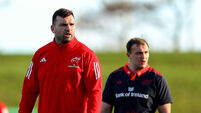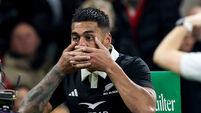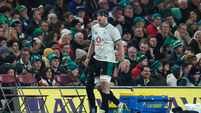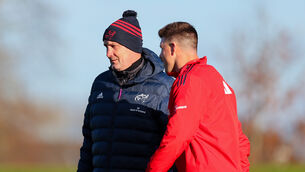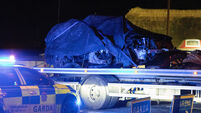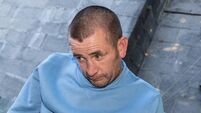Sky’s the limit
FOR an organisation acclaimed for its production of the biggest and most extravagant rugby broadcasts in the world, it is more than a little ironic that the match day nerve centre of Sky Sports is found in a tiny room on the back of articulated truck.
This claustrophobic space is Martin Turner’s playground. Turner is Executive Producer of Sky Sports Rugby Union, top of the food chain in these parts and like a great white shark, is constantly on the move leaving no one in any doubt about who rules this little fiefdom.
Then again when you are a BAFTA award winning director, and the longest serving staff member at Sky, such respect comes easy.
While Limerick slept last Saturday morning, Turner and his 70 strong crew of presenters, reporters, analysts, technicians, riggers and camera men arrived on site at Thomond Park shortly after 8am to prepare for an emotional farewell to the old stadium.
“Thomond Park is tribal,” he agrees. “The people here create an atmosphere which is electric. You get it in Madison Square Garden, at Lords, at Wembley, at Lansdowne Road and here in Limerick. It is that special.”
These pre-match hours are the most important time, checking, re-checking and triple checking all the connections and feeds which allow him to communicate with his team. Many of the staff are freelance with Irish company, TV Mobiles, providing the majority of the hardware. A dry run of the sound effects, video and other components of the day’s transmission follows. In all it takes an hour.
“Communication is the key. If I lose three or four cameras I can still do the job but if I lose the ability to talk to people it is nearly impossible. We use very good facilities. These guys on the technical side take a lot of the worry out of things that could be a source of great concern.”
But some things are outside of Turner’s command.
“The weather in general does not upset our ability to send a signal to the satellite but from a health and safety perspective it does dictate some of our camera angles.
“For example our big galaxy crane hoist is 250 feet high but we cannot use it if the wind is over 26 miles per hour. If the wind reader onboard hits that figure we bring it down. But at least high winds never threaten a match - unlike heavy rain. But we have a contingency plan or two in place if a game is called off. So for Saturday, the standby game is last year’s Heineken Cup final.”
With the technical review complete, the crew concentrate on preparing for the actual broadcast.
Saturday’s effort was one of the more complex productions. Not alone is there the game to worry about – the entire triple header of matches - Castres v Wasps, Sale v Ospreys and Munster v Leicester, is being anchored from Thomond Park. So in essence it is an outside broadcast within an outside broadcast, giving more scope for difficulties.
The technology is staggering. The signal from the Munster game is fed from the Outside Broadcast Unit to two satellites above the equator. (Two satellite vans are in place feeding the information upwards in tandem. But one is merely there as a backup).
These bounce the signal down to the earth station in Southampton. This signal is then fed by fibre optic cables (the width of a pencil) to Sky HQ at Osterley in Middlesex. It is then refed back to the uplink station and up to the Astra satellite, to be received by viewers in Ireland and the UK.
This whole process takes a maximum of five seconds (for OB games in the UK this is reduced by half, as the signal goes directly via fibre optics to the uplink tower).
Given the historic significance of the occasion, Saturday’s broadcast has a few more variables than the bread and butter interviews. The midweek advance party noted a pre-match parade of fans from the city centre to Thomond.
Before noon, Turner is working out the logistics of getting crews there and back; who’s filming, who’s editing and most importantly where it will appear in the day’s broadcast. By midday there is a stir. The teams have arrived in France for the Castres v Wasps game.
Explained Turner: “We are beginning to get real footage from France via satellite. So we show that to the presenter and the experts and work that into the running order.”
The running order spills to nine pages and contains over 200 notes and guides - from which promo is to be aired and when to sequence the graphics for a particular segment.
Ironically, match time is one of the quieter periods.
Saturday’s opener from Stade Aime Giral comes courtesy of French television, so Sky just relay the pictures with their commentary team of Will Chignell and Dewi Morris providing the words.
Things start to get a little hectic five minutes from the interval as the Thomond Park studio of Simon Lazenby, Will Greenwood, Paul Wallace and Michael Lynagh are called into action.
IT all goes without a hitch with Lazenby a model of serenity and authority despite having two voices in his headset nudging him towards the restart. He does a live voice over for Ricky Hatton’s fight on Sky Box Office, having checked the correct pronunciation of Juan Urango’s surname. With all watching Colombians proud of his efforts he finishes just as the second half kicks off.
The process is repeated again at full time before the switch to the second game – Sale Sharks v Ospreys which is being handled by Sky’s second unit in Manchester.
But of course things go wrong - the referee plays almost eight minutes of additional time cutting a huge chunk off the pre match build up for the Munster match. Interviews with Pat Howard and Declan Kidney are binned. The fan shots of the parade are the priority.
Turner sits front and centre in the room, to his left is Kathy the PA who has a variety of stopwatches and makes sure everything goes according to schedule. To his right sits Ross the vision mixer who has spent the day operating a huge desk of buttons, knobs and faders.
Ironically he will be largely unused during the live match – as given the speed of rugby and soccer – the time delay between the director’s orders and the mixer’s actions could be catastrophic.
So Martin, as is the norm for most sports directors, ends up doing the job himself.
In front of them is a bank of about 70 monitors, showing all the camera angles, preview shots and other feeds. Behind them sits Julian, the producer, Kevin the production manager, and a guest, Gérald Borreani the television match official (TMO) from France.
To our left there are technical gurus who are managing all the cables and wires, to the right is a battery farm of video operators, who are recording footage from all the cameras, and can be called on with only a few seconds notice.
Around the corner, Russell, Bill and Dan are in the Alstron Elliot van where all the statistics and graphics are compiled and produced. Twenty feet away, sits Nigel Redmond in the ‘Front Line’ truck which is a mini version of Turner’s zone. All are in audio contact with the command centre.
Turner calls for hush as the final pre-match ad break comes to an end. He is conscious that this is more than a game, more than about home quarter-finals.
“As well as covering the game, the real challenge is to appreciate the atmosphere. We have great camera men, great experts and great people but all of that combined means nothing if you can’t bring the feeling of the ground to the viewers,” he says.
TURNER can claim some credit in Munster’s Heineken Cup title success in Cardiff last May. He made the decision to put the Limerick crowd scenes on the big screen in the Millennium Stadium - a moment hailed as significant by many of the winning players in the aftermath.
“I think we achieved it at last year’s Heineken Cup Final in the Millennium Stadium when we put the pictures of Limerick on the big screen. The fans at home got closer at that moment and felt they were part of what was going on.
“I have stood and watched big screens, and you feel part of the crowd and feel a great sense of belonging. On that day perhaps, I’d like to think that those watching at home in O’Connell Street felt part of that whole occasion in Cardiff. It was one of those ‘I was there moments’.”
He sets about recapturing that sensation, calling for crowd shots and instantly a series of options pop up on the screens. All of the time he is multi-tasking — talking, complimenting and cajoling the 17 camera men while mixing the pictures that are being beamed across the world.
He wants a shot of the lights, ‘a bit wider, a bit wider’ he wants the crowd ‘anyone got a flag’ not stopping until he is happy with the end product.
Not alone is he talking to the camera crew, he is also in the ears of the commentary team of Mark Robson and Stuart Barnes. As Munster leave the dressing room, he orders the duo to fall silent.
This is one time when a picture paints a thousand words. He calls for a shot of the team emerging from a sea of red. This is going to be epic.
The pace in the booth is as frenetic and relentless as anything on the pitch. Every Turner command is followed – and nothing is taken for granted. Every score update, pool standings or player stats graphic is requested and aired on his command. Young Ian Humphreys is catching the eye, so a comparative record with O’Gara is called for. Seconds later it pops up on the screen courtesy of the stats truck before the shot of the Ulster man fades into the face of the Irish international.
There is very little to excite the crowd as both sides trade early punches in the rain. Then the Tigers pounce with Geordan Murphy touching down in the corner. The crew switch to overdrive. Pictures of celebrating Leicester fans buy the video replay operators a few seconds. To Turner’s right are colour-coded screens where the edited replays are uploaded. He calls for yellow, for red, for green with each offering a different angle of the try.
On the last replay he calls for super slow motion, and then normal speed when the Kildare native grabs the ball. All the while Barnes is analysing the score and, with consummate timing, the sequence ends as Humphreys prepares for the conversion.
“Like in sport, we are always trying to buy ourselves time — those extra few seconds are crucial. If I am chasing my tail during a broadcast then I could miss a live play. So we are always, like a sports person, looking for the little holes to attack. But you only want to show something again if it is incredibly exciting but always remembering that what is coming next is the most important thing.”
And that’s where the likes or Ronan O’Gara come in handy. Next time you are watching a rugby game, note the number of replays that the match director squeezes in the time between a try being scored and a conversion attempt.
“I’ve being watching Ronan for years, so I know how long I have got to play with before I go back to him. I can work out it in my head depending on the difficulty of the kick. Obviously if the conversion attempt is straight in front of the goals, I might only have time for one replay but if he is kicking from our wide that might rise to three. All regular kickers are very consistent in their routines.”
NIGEL REDMOND has spotted something he would like to air. Julian informs Martin and at the next break in play Robson calls in The Front Line – which is completed in less than 20 second – without a moment of live action being missed. Julian is back on the link to Simon with a guide for the half time discussion. Naturally Murphy’s try will form the centre piece with a discussion also on the strength of the Leicester scrum. However Redmond informs the booth that he will be doing a piece on the scrum – so another topic will be found.
“It is highly pressurised but it is great fun. Lots of people, and very talented people, don’t enjoy live productions but I get an enormous buzz working in this kind of environment. There is nothing like the few seconds before we go live. It is like the countdown to the grid lights switching green at a Formula One race or the referee about to blow his whistle to start a match. That is why so many past players enjoying doing the analysis of games as it allows them to recapture some of that rush.”
The second half is forgettable from a Munster perspective. The decision to turn down three points and opt for the scrum is one of the key points with the video operators desperately trying to find any close up of the players in the seconds before the call was made.
Given the inevitability about the result the final whistle can’t come soon enough. The brief for the camera crew is simple — seek out dejection and tears in red – and the shots are there in abundance.
The panel nod sagely, the post match interviews come fast and furious from Graham Simmons before the show ends just before 8pm. Turner thanks the crew for their efforts in appalling conditions before adding: “don’t blame me for the weather. It’s your country.”
A 12 hour day has just come and gone. There is little time for rest and relaxation. A charter plane sits on the runway at Shannon airport, waiting to whisk the crew to Luton before they are bussed to Northampton ahead of Sunday afternoon’s feature presentation against Biarritz.
“I am driven by a passion for what I do. I love the job and the subject. The day that directing great sport becomes a job I will give it up.”
All you need is.....
Three km of cable,
Seventeen cameras,
Fifteen microphones,
Two satellite trucks,
Seventy production staff, including technicians and riggers and
Twenty production staff at HQ in Middlesex.






